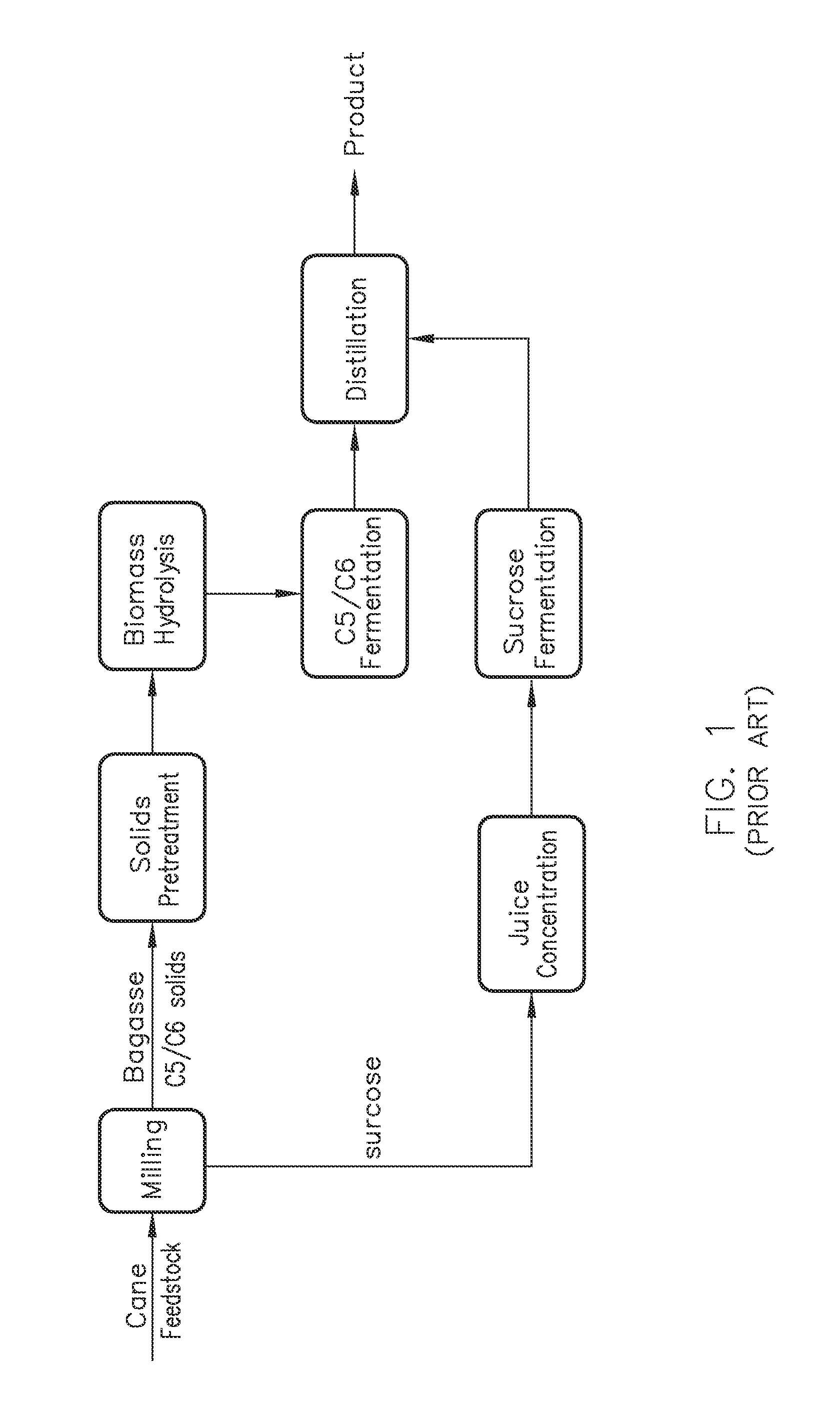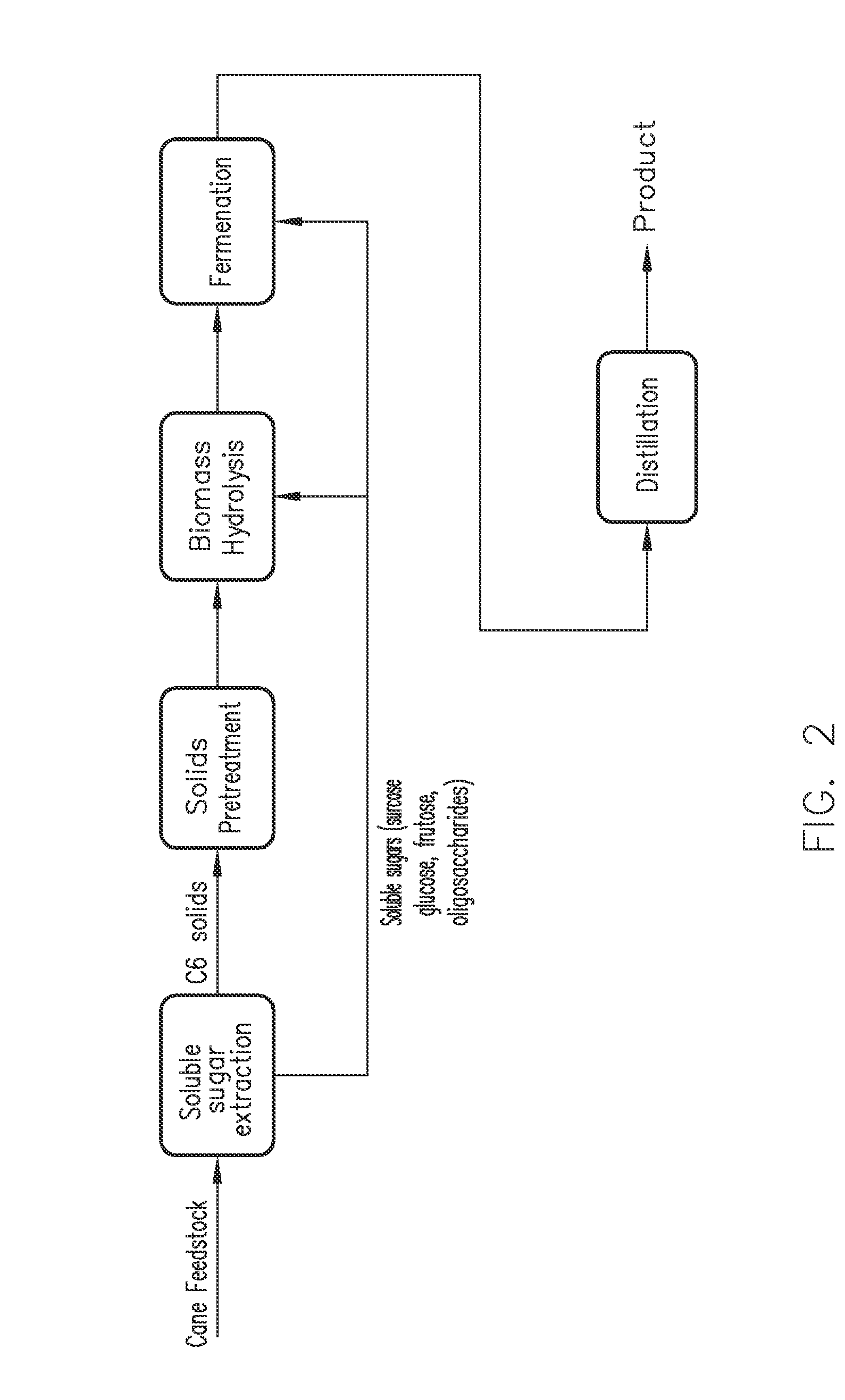Liquid co-extraction process for production of sucrose, xylo-oligosaccharides and xylose from feedstock
a technology of xylose and xylan, which is applied in the field of liquid co-extraction of sucrose and xylan from feedstock, can solve the problems of affecting the production of ethanol or other biochemicals, allowing soluble sugars to continue into a conventional pretreatment process, and reducing the extraction efficiency of soluble sugars, so as to achieve the maximum utilization of all sugar fractions of feedstock, improve the extraction efficiency, and improve the conversion process. the effect o
- Summary
- Abstract
- Description
- Claims
- Application Information
AI Technical Summary
Benefits of technology
Problems solved by technology
Method used
Image
Examples
example 1
Sugar Extraction from Milled Energy Cane
[0061]Raw energy cane (stalks only) was milled using a knife mill, the juice was removed and the collected wet solids were used in a trial of sugar extraction. For each trial condition, four individual fiber samples were prepared, ranging in mass from 20 to 40 g (wet basis; estimated moisture content approximately 65%). Water was added to each sample vessel, in an amount approximately double the wet mass of the energy cane sample. The sample vessels were sealed and the contents cooked in an autoclave at 125° C. for 1, 2, 3, or 4 hours. For each temperature / time combination, the four individual samples were pooled after cooking. The pH of the liquid extract was measured and compared with the initial pH of 6.2, and the sugar and inhibitor content of the liquid extract was measured using HPLC, on an Agilent 1200 series HPLC system with a Biorad carbohydrate column and a Biorad organic acids column. A set of standards was run co-currently, as a be...
example 2
Sugar Extraction from Cut Energy Cane Billets
[0063]Raw energy cane was cut into lengths, and the collected billets were used in a trial of sugar extraction. For each trial condition, four individual fiber samples were prepared, ranging in mass from 15 to 23 g (wet basis; estimated moisture content approximately 65%). Water was added to each sample vessel, in an amount approximately double the wet mass of the energy cane sample. The sample vessels were sealed and the contents cooked in an autoclave at 125° C. for 1, 2, 3, or 4 hours. For each temperature / time combination, the four individual samples were pooled after cooking. The pH of the liquid extract was measured and compared with the initial pH, and the sugar and inhibitor content of the liquid extract was measured using HPLC, on an Agilent 1200 series HPLC system with a Biorad carbohydrate column and a Biorad organic acids column. A set of standards was run co-currently, as a benchmark of sugar recovery and degradation. Concent...
example 3
Control—Hydrolysis and Degradation of Raw Sucrose Juice
[0065]10 wt % sucrose solutions were prepared by dissolving 1.2 to 1.7 g of crystalline sucrose in water. The resulting solutions were transferred into sample cook vessels and sealed, then cooked in an autoclave at 125° C. for 1, 2, 3, or 4 hours. The sugar content and inhibitors content of the liquid extract was measured using HPLC, on an Agilent 1200 series HPLC system with a Biorad carbohydrate column, and a Biorad acids column. A set of standards was run co-currently, as a benchmark of sugar recovery and degradation. Concentrations of sucrose, glucose, xylose, fructose, acetic acid, formic acid, furfural and HMF were determined.
[0066]Key results are summarized in Table 1. The percentage sugars extracted represents the aggregate amount of sucrose, glucose and fructose measured in the liquid samples. At incubation times from 1 to 3 hours, total sugars recovered matched the initial total mass of sucrose in solution. However, af...
PUM
| Property | Measurement | Unit |
|---|---|---|
| Temperature | aaaaa | aaaaa |
| Temperature | aaaaa | aaaaa |
| Temperature | aaaaa | aaaaa |
Abstract
Description
Claims
Application Information
 Login to View More
Login to View More - R&D
- Intellectual Property
- Life Sciences
- Materials
- Tech Scout
- Unparalleled Data Quality
- Higher Quality Content
- 60% Fewer Hallucinations
Browse by: Latest US Patents, China's latest patents, Technical Efficacy Thesaurus, Application Domain, Technology Topic, Popular Technical Reports.
© 2025 PatSnap. All rights reserved.Legal|Privacy policy|Modern Slavery Act Transparency Statement|Sitemap|About US| Contact US: help@patsnap.com



